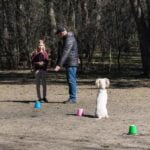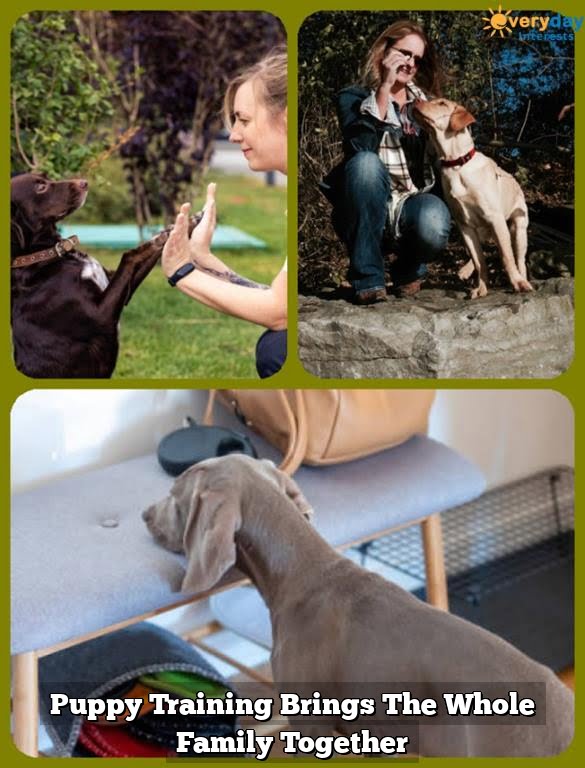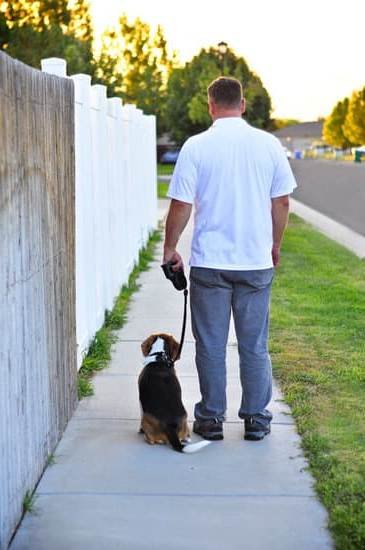Are you wondering how to train two dogs to walk together? Walking two dogs together can be a rewarding experience for both the pet owner and the dogs themselves. It promotes bonding between the dogs, provides them with mental stimulation, and helps them develop good behavior. However, proper training is essential to ensure a successful and enjoyable walking experience for everyone involved.
Understanding your dogs’ personalities and needs is crucial when it comes to training them to walk together. Each dog has its own unique personality and specific needs that must be taken into consideration during training. Additionally, basic training such as teaching each dog to walk on a leash and socialization are important steps in preparing them for walking together.
In this article, we will delve into the importance of walking two dogs together, the benefits of doing so, and the necessary steps to successfully train them for this activity. We will also discuss how to assess their individual personalities and needs, as well as provide tips on understanding their behavior and reactions while walking.
Whether you’re a seasoned pet owner or new to walking multiple dogs at once, this guide will equip you with the knowledge and techniques needed for a harmonious and enjoyable walking experience with your furry friends.
Understanding Your Dogs’ Personalities and Needs
When it comes to training two dogs to walk together, it is essential to understand the individual personalities and needs of each dog. Just like humans, dogs have unique characteristics and behaviors that must be taken into consideration when training them. This section will provide tips on how to assess your dogs’ personalities and needs, as well as understanding their behavior and reactions while walking.
Firstly, it is important to spend time getting to know each dog on a one-on-one basis. Take note of their likes, dislikes, fears, and triggers. Some dogs may be more social and outgoing, while others may be more reserved or reactive to certain stimuli. Understanding these differences will help you tailor your training approach to suit the specific needs of each dog.
Additionally, observing their behavior during walks is crucial in understanding how they react to different situations. Pay attention to their body language, response to other animals or people, and any signs of stress or agitation. This insight will allow you to anticipate potential challenges during walks and effectively address them.
In summary, taking the time to understand your dogs’ personalities and needs is fundamental in creating a successful walking experience for both pets. By tailoring your training methods based on their individual characteristics and behavior, you can ensure a harmonious walk for both dogs.
| Understanding Your Dogs’ Personalities | Needs |
|---|---|
| Assessing individual personalities | Observing likes, dislikes, fears |
| Understanding behavior during walks | Addressing signs of stress or agitation |
Basic Training
Teaching your dogs to walk on a leash is an essential part of preparing them to walk together. It allows you to have control over their movements and behavior while ensuring their safety and the safety of others around them. Here are some steps to follow when training each dog individually:
- Introduce the leash gradually: Begin by allowing your dog to familiarize themselves with the leash by letting them smell it and get used to its presence before attaching it to their collar.
- Positive reinforcement: Use treats or verbal praise to reward your dog for walking beside you on the leash without pulling or trying to remove it. This will encourage good behavior and make them associate walking on a leash with positive experiences.
- Practice in a quiet environment: Start training in a quiet and familiar environment where there are minimal distractions, allowing your dog to focus on learning how to walk on a leash without getting overwhelmed.
Understanding each dog’s personality and individual needs during this training process is crucial. Some dogs may take longer to adjust to walking on a leash, while others may pick up the skill quickly. Being patient and observant of their reactions is key in determining the most effective approach for each dog.
It’s important not to force your dogs into uncomfortable situations or pull on the leash aggressively. This can lead to negative associations with walking on a leash, making the overall training process more challenging. Instead, practice gentle guidance and encouragement as you gradually introduce the concept of walking on a leash to each dog. Remember, every dog is unique, so be flexible in your approach and personalize the training method according to their specific needs and behavior patterns.
Overall, teaching each dog how to walk on a leash requires patience, consistency, and positive reinforcement. By taking the time to understand each dog’s individual needs and providing tailored training methods, you can prepare them for walking together successfully.
Socialization and Desensitization
When it comes to walking two dogs together, socialization and desensitization are crucial elements in ensuring a pleasant and enjoyable experience for both the dogs and their owners. By exposing your dogs to a variety of environments, people, animals, and stimuli, you can help them become more confident, calm, and well-behaved while out on walks.
This section will provide insight into the importance of socializing and desensitizing both dogs, as well as practical tips for introducing them to new surroundings.
Understanding the Importance of Socialization
Socializing your dogs from a young age is essential for their overall well-being and behavior. It helps them develop positive associations with different environments and prevents fear or anxiety towards unfamiliar sights and sounds.
When walking two dogs together, it’s important to expose them to various locations such as parks, busy streets, cafes, or even outdoor events where they can interact with different people and pets. This exposure will help them feel more at ease in public settings and reduce the likelihood of unwanted behaviors such as excessive barking or pulling on the leash.
Tips for Desensitizing Your Dogs
Desensitization involves gradually exposing your dogs to specific stimuli that may trigger fear or anxiety in a controlled manner. For example, if one of your dogs has shown signs of fear towards loud noises or other animals while walking, you can start by introducing these stimuli from a distance and gradually decreasing the distance over time as your dog becomes more comfortable.
It’s important to be patient during this process and use positive reinforcement techniques such as treats or praise to encourage calm behavior. By desensitizing your dogs to potential triggers, you can help them stay focused and relaxed during walks.
When introducing your dogs to new environments, start with quieter areas before progressing to busier locations. Allow your dogs time to explore their surroundings at their own pace while keeping an eye on their body language for any signs of stress or discomfort.
Gradually increase the level of distractions they are exposed to while reinforcing good behavior with rewards. By taking small steps and being mindful of each dog’s comfort level, you can create positive experiences that will contribute to their confidence and adaptability while walking together.
Socialization and desensitization play crucial roles in preparing your dogs for successful walks together. When done effectively, these training methods can enhance the overall walking experience for both dogs while strengthening their bond with their owners.
Training Both Dogs to Walk Side by Side
When it comes to training two dogs to walk together, one of the most important skills to teach them is how to walk side by side. This not only ensures a pleasant and harmonious walking experience for both dogs but also makes it easier for the owner or walker to manage them. Here are some techniques for teaching both dogs to walk beside each other.
First, start with basic leash training for each dog individually. Make sure that both dogs are comfortable walking on a leash and responding to basic commands like “sit” and “stay”. Once they have mastered these skills separately, you can gradually start walking them together. Keep the leashes loose and allow them some space to move around while ensuring they stay close.
To maintain their focus and minimize distractions, use treats or rewards when both dogs are walking nicely beside each other. Every time they successfully walk without pulling or getting distracted, praise and reward them with treats. This positive reinforcement will help them associate walking side by side with something positive, making them more likely to repeat the behavior.
Consistency is key when training two dogs to walk side by side. It’s important to practice regularly and reinforce the behavior each time you walk them together. Over time, they will learn that walking calmly next to each other is expected behavior. Be patient and give them plenty of opportunities to practice this skill during walks in different environments.
| Walking Technique | Tips |
|---|---|
| Start with individual leash training | Teach each dog basic leash skills before attempting to walk them together |
| Use positive reinforcement | Reward both dogs when they walk nicely beside each other |
| Be consistent in practicing | Regular practice in different environments helps reinforce the behavior |
Dealing With Challenges
Dealing with two dogs exhibiting leash aggression and potential fighting while walking can be incredibly challenging, but with the right techniques, it is possible to overcome these issues and create a harmonious walking experience for both dogs. Here are some strategies for handling leash aggression and conflicts between your dogs:
- Identify Triggers: Pay attention to what triggers the leash aggression or fighting behavior in your dogs. It could be other animals, loud noises, or even certain people. Understanding the triggers can help you anticipate potential conflicts and take preventive measures.
- Redirect Attention: When you notice signs of leash aggression or potential conflict, redirect your dogs’ attention to something positive. Utilize treats or toys to shift their focus away from the trigger and towards a more calming and rewarding experience.
- Implement Desensitization Techniques: Gradually introduce your dogs to the stimuli that trigger their aggression in a controlled environment. By exposing them to these triggers in a controlled manner, you can help them become desensitized and less reactive over time.
In addition to these strategies, it’s crucial to remain calm and assertive during walks with both dogs. Your energy will directly impact their behavior, so maintaining a sense of control and composure is essential. Seeking professional help from a dog trainer or behaviorist can also provide valuable insight and guidance on how to address specific issues related to leash aggression and fighting.
By implementing these techniques consistently and patiently, you can work towards creating a peaceful walking experience for both of your dogs, ultimately strengthening their bond with each other as well as with you as their owner.
Advanced Training
Adding off-leash commands to your dogs’ training regimen can provide them with more freedom and allow for a more enjoyable walking experience for both you and your pets. However, before introducing off-leash commands, it is crucial to ensure that both dogs have mastered walking on a leash and have a strong recall response to their names.
Teaching Off-Leash Commands
To begin teaching off-leash commands, start by practicing in a secure and enclosed area such as a fenced-in yard or an empty park. Begin by calling each dog by their name individually and rewarding them with treats or praise when they come to you. Gradually increase the distance between you and the dogs as they become more confident with responding to your calls.
Ensuring Safety
When transitioning to off-leash walking, always make sure the environment is safe and free from potential dangers such as traffic or other animals. It’s also advisable to use a long line or retractable leash initially to provide some control while still allowing the dogs some freedom to explore.
Consistency Is Key
Consistency in training is crucial when introducing off-leash commands. Practice regularly in different environments to help reinforce the behavior and ensure that the dogs respond reliably to your calls regardless of distractions. Remember to reward good behavior consistently to reinforce their training.
By introducing off-leash commands into your dogs’ training regimen, you can enhance their walking experience while also strengthening their obedience skills. With consistent practice, patience, and positive reinforcement, you can train two dogs to walk together safely and enjoyably off-leash.
Consistency and Practice
In conclusion, training two dogs to walk together can be a challenging but ultimately rewarding experience for both the pet owner and the dogs. By understanding the individual personalities and needs of each dog, implementing basic leash training, socialization, and desensitization techniques, as well as teaching both dogs to walk side by side, pet owners can successfully train their furry companions to walk together in harmony.
Consistency and practice are key elements in establishing a routine for walking two dogs together. It is important to maintain consistency in training methods, rewards, and expectations for both dogs. Establishing a regular walking routine not only benefits the physical health of the dogs but also reinforces their training and behavior while on walks. With consistent training and practice, pet owners can ensure that their dogs continue to behave well while walking together.
It is important to remember that challenges may arise when training two dogs to walk together, such as leash aggression or potential conflicts between the dogs. However, by implementing strategies for diffusing confrontational situations and continuously reinforcing positive behavior through consistent practice, pet owners will be able to enjoy peaceful and enjoyable walks with both of their beloved pets.
Ultimately, with patience, dedication, and the proper knowledge of how to train two dogs to walk together effectively, pet owners can turn what might have seemed like a daunting task into a harmonious bonding experience for everyone involved.
Frequently Asked Questions
Is It OK to Walk Two Dogs at the Same Time?
Yes, it is okay to walk two dogs at the same time as long as you can control them both and they are both well-behaved on the leash. It’s important to consider the size and strength of the dogs when walking them together.
How Can I Make My Two Dogs Walk Easier?
Making walks with two dogs easier can involve using a double leash or coupler to keep them close together and prevent tangling. Additionally, training each dog individually to walk nicely on a leash can make the experience more manageable when walking them both together.
How Do You Walk Two Dogs Without Pulling Them?
Walking two dogs without pulling requires consistent training and patience. Using techniques like stopping when they pull and rewarding them for walking nicely can help reinforce good behavior. It’s also important to use positive reinforcement rather than punishment during training sessions.

Welcome to the blog! I am a professional dog trainer and have been working with dogs for many years. In this blog, I will be discussing various topics related to dog training, including tips, tricks, and advice. I hope you find this information helpful and informative. Thanks for reading!





